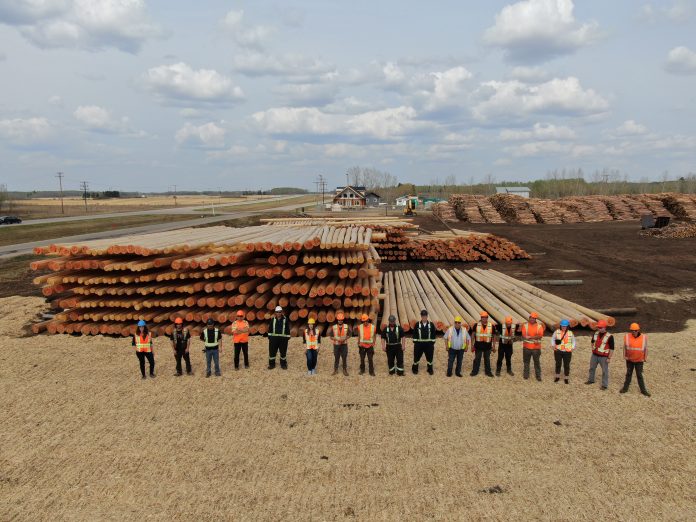
One-year phase out of penta, without a reliable alternative, too short for Spruce Home’s Vermette Wood Preservers
A Saskatchewan wood treatment company is speaking out about the potential impacts of Health Canada banning its only preservative.
Health Canada’s Pest Management Regulatory Agency (PMRA) has announced that it’s prohibiting the oil-borne preservative pentachlorophenol, known as penta, starting in October. It made the announcement last year to allow a one-year phase out period to exhaust all penta products.
According to its report, penta poses risks to the environment, such as to aquatic species and releasing micro-contaminants into the atmosphere, as well as to human exposure through wood treatment facilities and the general public’s exposure to penta-treated wood.
While these risks are not “imminent and serious,” according to the report, the decision threatens the future of Vermette Wood Preservers.
“For us to dispose of this in that timeline…for me? Million and a half dollars. I’m broke, I’m done. I will not survive,” said owner Perry Vermette.
The Indigenous business in Spruce Home, north of Prince Albert, has been operating since 1973.
Since 1980, said Vermette, they’ve solely used penta to treat wood used for utility poles and cross-arms. According to Vermette, the business is the primary provider for SaskPower and the province’s Department of Highways.
He said the alternative to penta, called DCOI, is expected to start the approval process in Canada in 2024 — but that still leaves a large time period in between where Vermette won’t be able to run his business.
“If PRMA does not approve the DCOI pretty much immediately, we can’t operate. Thank you for approving it in a year and a half, but if they approve it now, that will give us enough time to, number one, go to the manufacturer in the US, there’s only one, and place our orders. Well, everybody is placing those orders, not just Vermette’s. Then we have to re-tool our plans,” he said.
“If you allow them to have enough time to use up their inventory, then great. There will be a nice transition period where penta’s moving out, DCOI is moving in.”
Transitioning from using Penta to DCOI would require changes in equipment that would cost about $200,000, said Vermette.
Vermette said Health Canada is suggesting they turn to a preservative called Chromated Copper Arsenate (CCA), which he said cannot be used in water on bridge timber.
Health Canada considering extended deadline to use up penta-treated poles
In March, Saskatchewan’s Minister of Crown Investments Corporation Don Morgan wrote a letter to Canada’s minister of health, Jean-Yves Duclos.
The letter states that SaskPower purchases about 30,000 poles a year, primarily treated with penta, and maintains an inventory of about 25,000.
“The abrupt 12-month phase out period determined by PRMA, without prior consultation with stakeholders, will significantly impact Saskatchewan’s crown utilities, including SaskPower and SaskTel, our forestry businesses and suppliers and local Indigenous companies who produce these wood poles,” wrote Morgan.
He requested that the PRMA extend the deadline to 2027 to use up penta-treated products.
In an emailed response to the Prince Albert Daily Herald, Health Canada said it published a document in 2020 to outline its plans to prohibit penta and to receive feedback.
According to the email, Health Canada provided a group of stakeholders, including Vermette Wood Preservers, with an update prior to announcing official plans to phase out penta.
“Health Canada takes the supply challenges that stakeholders and users of products treated with pentachlorophenol could face seriously,” it reads.
“Health Canada is currently reviewing an application to register pentachlorophenol-treated wood poles and cross-arms. This would allow electrical utilities to continue to install pentachlorophenol-treated wood poles that have previously been treated for an extended period of time. It would not, however, allow the treatment of new poles.”
The email also said that materials other than wood, such as steel, concrete or fibreglass, can be used for utility poles.
However, Wood Preservation Canada said switching supplies in order to meet the demand would take several years.
“The wood industry is the only industry that can provide a readily available supply of utility poles needed for things such as natural disaster relief efforts.”
‘No poles, no power’
Vermette said disruption to utility pole supply could cost lives if an extreme weather event occurs in the province. He referred to the ice storm that hit Quebec and Ontario earlier this year.
Millions of homes were left in the dark after the spring storm knocked down power lines. One man died after he brought his generator in his garage in order to stay warm, dying of carbon monoxide poisoning.
“Can you imagine when that happens in Saskatchewan, where we’re so spread out? There’s no way we can manage our infrastructure when we have a major disaster,” said Vermette.
To him, the issue can be summed up simply, even though the consequences are far more complex than it seems:
“No poles, no power.”

